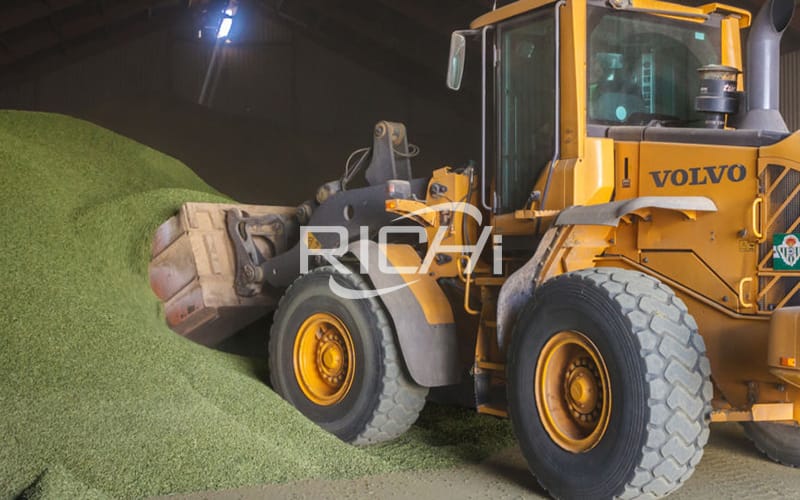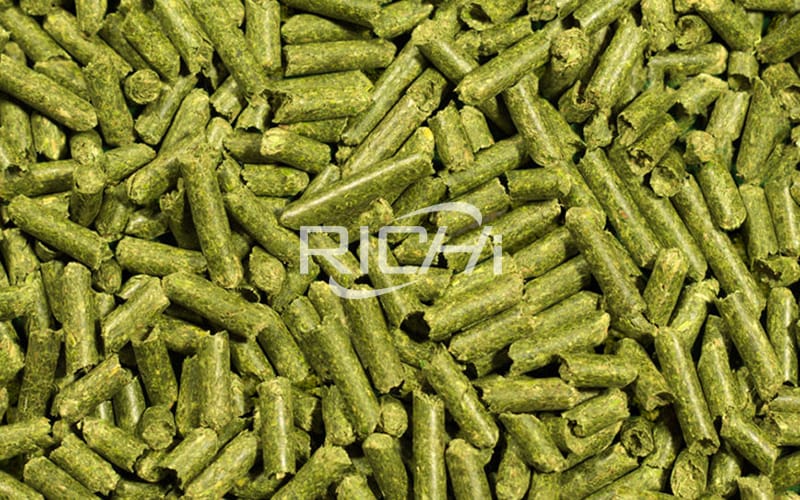What feed does the cow eat? How to prepare cattle feed?

1. roughage
Coarse feed refers to a type of feed that is bulky, difficult to digest, has less available nutrients, and has a higher content of crude fiber in dry matter. It mainly includes hay, agricultural and sideline products, leaves, and dregs. The roughage has the following three characteristics:
(1) The nutritional value is not high
The nutrient content of roughage is generally low and the quality is poor. In terms of crude protein content, leguminous hay is better than gramineous hay, and hay is better than crop by-products. Some crop seedlings, vines, vines and leaves are equivalent to or even better than hay; the pods and shells of crops are slightly higher than gramineous straws, and gramineous straws are the lowest.
(2) Cheap and large in stock
Rough feed is the most important and cheapest feed for beef cattle. In pastoral areas, there are vast grassland pastures to provide forage; in agricultural areas, hundreds of millions of tons of crop straw are available every year, and weeds are also available everywhere. Except for the cultivation of pasture and the improvement of pastures and pastures, a certain amount of investment is required. The drying of hay and the use of straw do not require much investment, so it is very popular among farmers and herdsmen.
(3) High crude fiber content, poor palatability and low digestibility
The texture of roughage is generally hard, the content of crude fiber is high, and the palatability is poor, so the utilization of this type of feed by livestock is limited. However, because of the large volume and rough texture of roughage, it has a certain stimulating effect on the intestines and stomachs of livestock. For beef cattle, this stimulus is conducive to their normal ruminating, and it is an indispensable type of feed in the feeding process. In addition, although roughage is supplied and sold for its nutritional value, it is large in size. If taken in a proper amount, the body will feel full.
2. Concentrated feed
Concentrated feed includes energy feed, protein feed, mineral feed, trace (macro) elements and vitamins. Energy feed mainly includes corn, sorghum and barley, etc., which account for about 60% to 70% of concentrated feed. Protein feed mainly includes soybean cake (meal), cotton seed cake (meal) and peanut cake, which account for about 20% to 25% of concentrated feed. The maximum daily feeding amount of cotton seed cake (meal), soybean cake (meal) and peanut cake should not exceed 3 kg.
3. Green feed
Green feed refers to a plant feed with a natural moisture content of more than 60%. It is named after it is rich in chlorophyll. It includes natural grass, cultivated grass, field weeds, young shoots and tender leaves, aquatic plants and vegetable leaf melon and rattan feed. Wait. Green fodder can be better used by livestock and has a complete variety. Compared with roughage, it also has the advantages of wide source, low cost, convenient collection and simple processing, and its nutritional value is higher than roughage.
(1) Higher protein content
Green feed is rich in protein, and using it as a basic diet for beef cattle can meet the relative protein requirements of beef cattle under various physiological conditions. Calculated by dry matter, the crude protein content in green forage is more than that in gramineous seeds. For example, the crude protein content in alfalfa hay is about 20%, which is equivalent to 2.5 times the crude protein content in corn seeds, which is about soybean cake. Half of it.
(2) Rich in vitamins
Green fodder is rich in a variety of vitamins, including vitamin B family and vitamins C, E, K, etc., especially carotene. Each kilogram of green fodder contains 50-80 mg, which is a cheap source of various vitamins. If a certain amount of green feed is often guaranteed in the diet, it can basically meet the nutritional needs of beef cattle vitamins (but green feed does not contain vitamin D and needs to be supplemented from other feeds)
(3) Low crude fiber content and good palatability
Green fodder is soft and juicy, has low cellulose content and good palatability, which can stimulate the feed intake of beef cattle. Moreover, due to its balanced nutrition, a certain amount of green fodder in the diet can also increase the utilization of the entire diet.
(4) Large volume, high moisture content
The moisture content of fresh green fodder is generally 75%-90%, and that of aquatic plants is as high as 95%. On the one hand, it is one of the main ways for beef cattle to take in water; on the other hand, it also reflects the low nutrient concentration of green fodder, especially the digestible energy only contains 1250-2500 kJ per kilogram of fresh weight. Therefore, it is not enough to satisfy all the nutrients of beef cattle with green fodder.
(5) Appropriate ratio of calcium and phosphorus
The minerals in the green feed account for about 1.5%-2.5% of the fresh weight, which is a good source of minerals.

4. Mineral feed
Mineral feed includes bone meal, salt, baking soda, trace (major) elements, and vitamin additives, which generally account for 3% to 5% of concentrated feed. The addition of fattening bone meal for young cattle accounts for about 2% of the amount of concentrated feed, the fattening of shelf cattle accounts for 0.5% to 1%, and the amount of addition in summer accounts for 1% to 1.2% of the amount of concentrate. When using distillers' grains as the main coarse feed, baking soda should be added, and the added amount accounts for 1% of the concentrated feed. When feeding cattle with other roughages, 0.3% to 0.5% of concentrated feed can be added in summer.
5. Silage
Silage is a kind of roughage obtained by cutting the green feed with a moisture content of 65%-75%, and under the condition of airtight hypoxia, through the fermentation of anaerobic lactic acid bacteria to inhibit the reproduction of various miscellaneous bacteria . Silage has a sour smell, soft and juicy, good palatability, rich nutrition, and is good for long-term preservation. It is an excellent source of feed for raising cattle.
There are many cattle farmers who feed their cows with pig and chicken feed. They think that the cows eat pig feed and chicken feed grow faster. In fact, it is not. Pigs, chickens and cows have different digestive structures and different nutrients. In addition, pig and chicken feed may contain antibiotics that can damage the rumen microbiota of cattle, so pig and chicken feed are not suitable for feeding cattle. So what feed does the cow eat to grow fast? Here is a detailed introduction to this issue.
Cattle is a herbivorous ruminant. The diet needs to be based on roughage. However, because the nutritional value of roughage is relatively low, it is difficult to meet the nutritional needs of cattle in the growth period. Therefore, it is necessary to feed a certain amount of concentrated feed for fattening. Take cattle as an example, the ratio of roughage to concentrate in general diet is about 6:4.
There are a lot of roughages available for cattle to eat. All kinds of weeds, pastures, crop stalks and dregs can be eaten by cattle. However, the nutritional value of various types of roughages is quite different. Cattle farmers can choose 2~3 kinds of high-quality roughage to match together according to local resource conditions. Fresh pasture (especially legume forage), silage corn stalks, soybean stalks, peanut seedlings and distiller’s grains are all high-quality roughage resources for cattle. However, pregnant cows should be cautiously fed distillers grains so as not to affect the normal growth and development of the fetus.
Concentrated feed needs to be scientifically formulated with raw materials such as corn, soybean meal, wheat bran and premix to meet the nutritional needs of cattle growth and development. Welcome to pay attention: efficient cattle breeding, WeChat public account. Some cattle farmers only feed corn or wheat bran to cattle. This is obviously not enough. The formula for fattening cattle concentrates is as follows: corn 60%, soybean meal 22%, wheat bran 10%, premix 4%, calcium carbonate 1.2% , 2% baking soda, 0.8% salt, 0.02% super resistance, you can adjust slightly according to the actual situation, for example, you can feed more soybean meal and wheat bran in the early and middle fattening period, and feed more corn and less corn in the late fattening period Feed some wheat bran.
In addition to a reasonable ration, cattle farmers also need to ensure the quality of raw materials and proper processing. Feeding cows with poor-quality, mildew and other feeds will affect their growth. Therefore, cattle farmers should strengthen the storage of feed and prohibit feeding poor-quality, mildew, frozen, and silt-containing feed. The feed also needs to be properly processed to achieve high palatability and digestibility. For example, wheat stalks and rice straws with high crude fiber content can be short ammoniated, corn stalks can be silaged, and finally mixed with water Wet, so that the palatability and digestibility of the feed can be maximized. Cows eat more and the digestion and utilization are high and naturally grow faster!
[More info about cattle feed]
(1)how to make cattle feed with maize residue?
(2)procedure to open cattle feed plant in qld
(3)cow manure pellet machine with China factory price
(4)cattle feed process flow chart
(5)cattle feed mill at empangeni
(6)cheap price cattle feed making hammer mill
(7)cattle pilot sheep feed processing plant euqipment
(8)raw materials for cattle feed production
(9)energy consumption by cattle feed manufacturing process
If you want to built one complete pellet production line in your country, pls send the inquiry to us. We will customized design according to your requirement.



